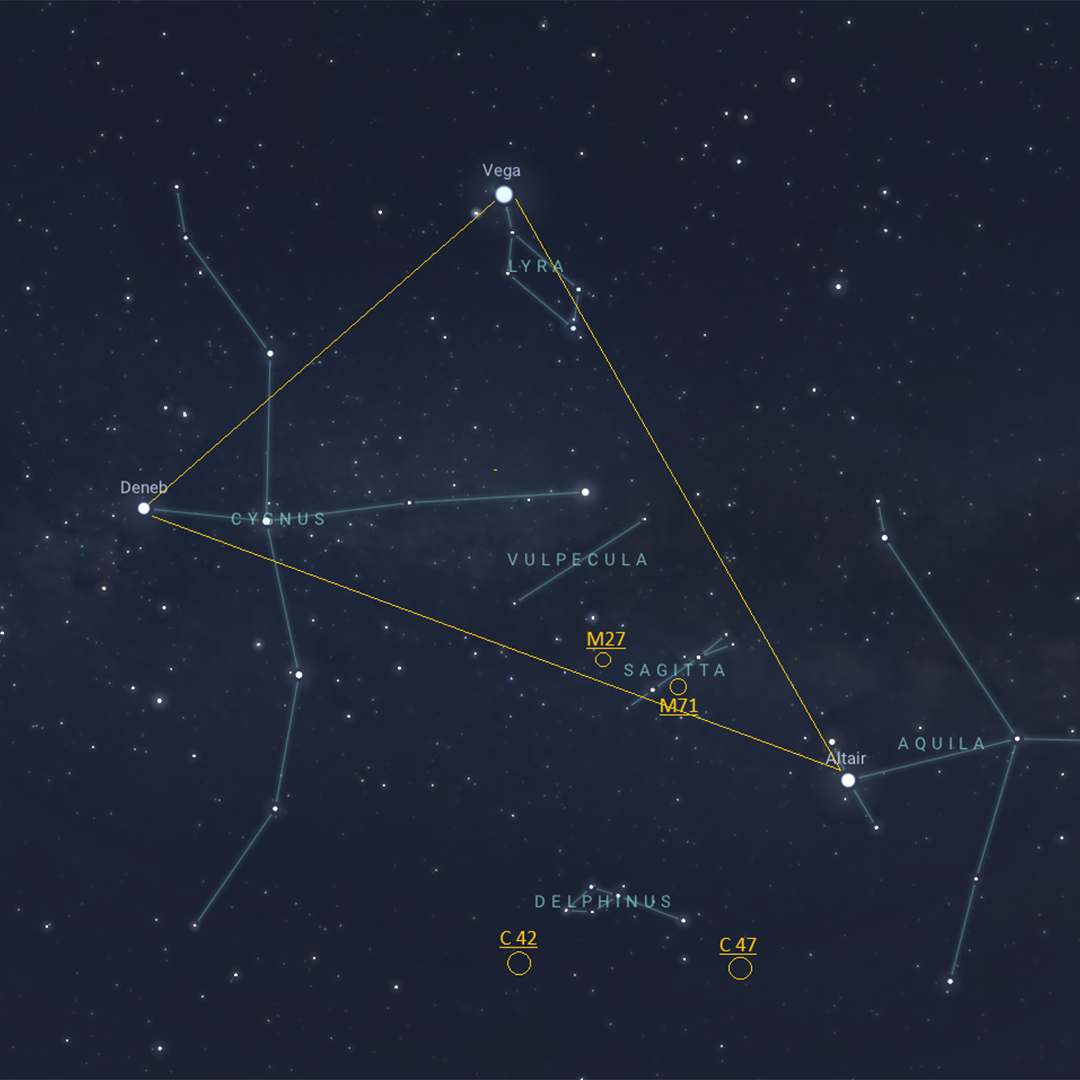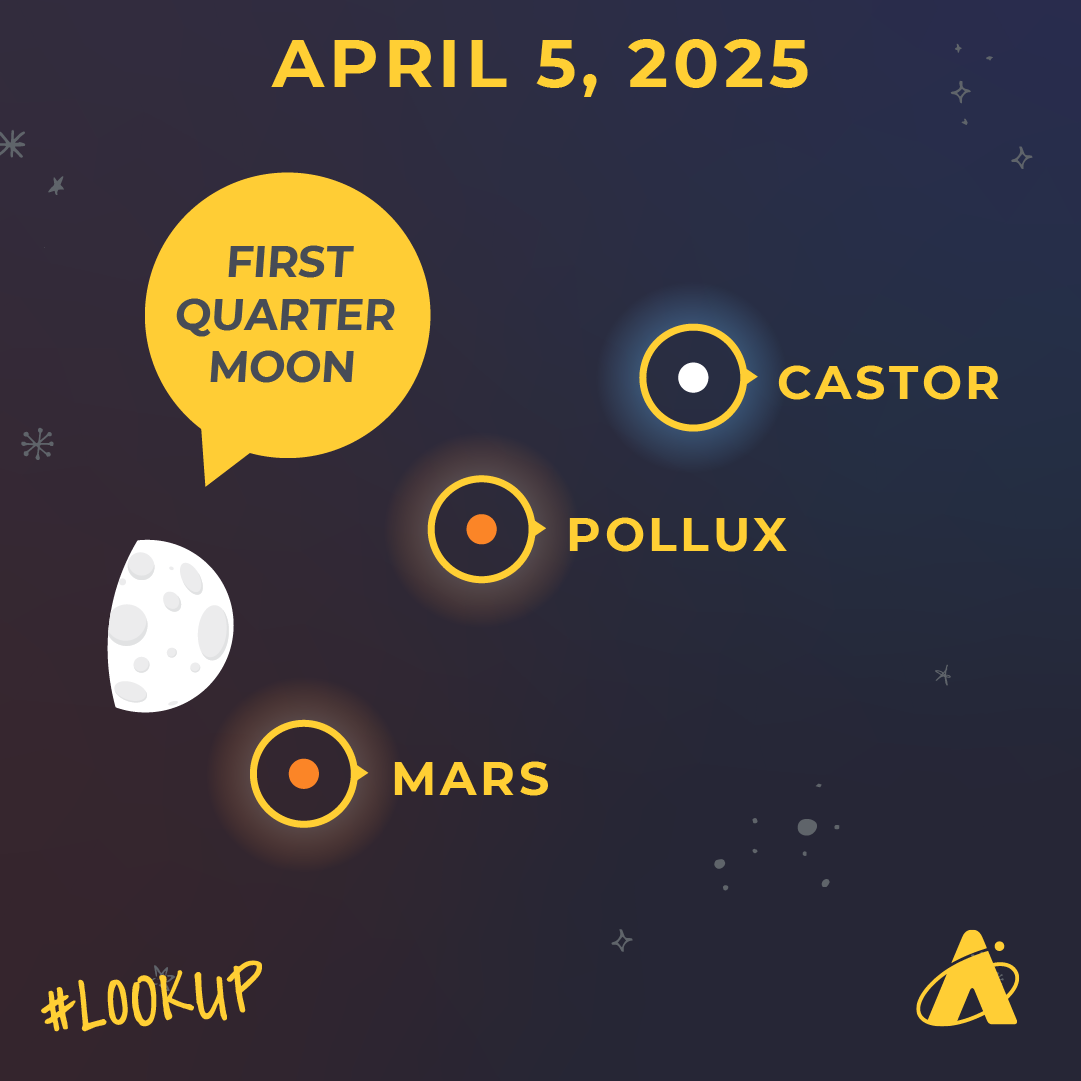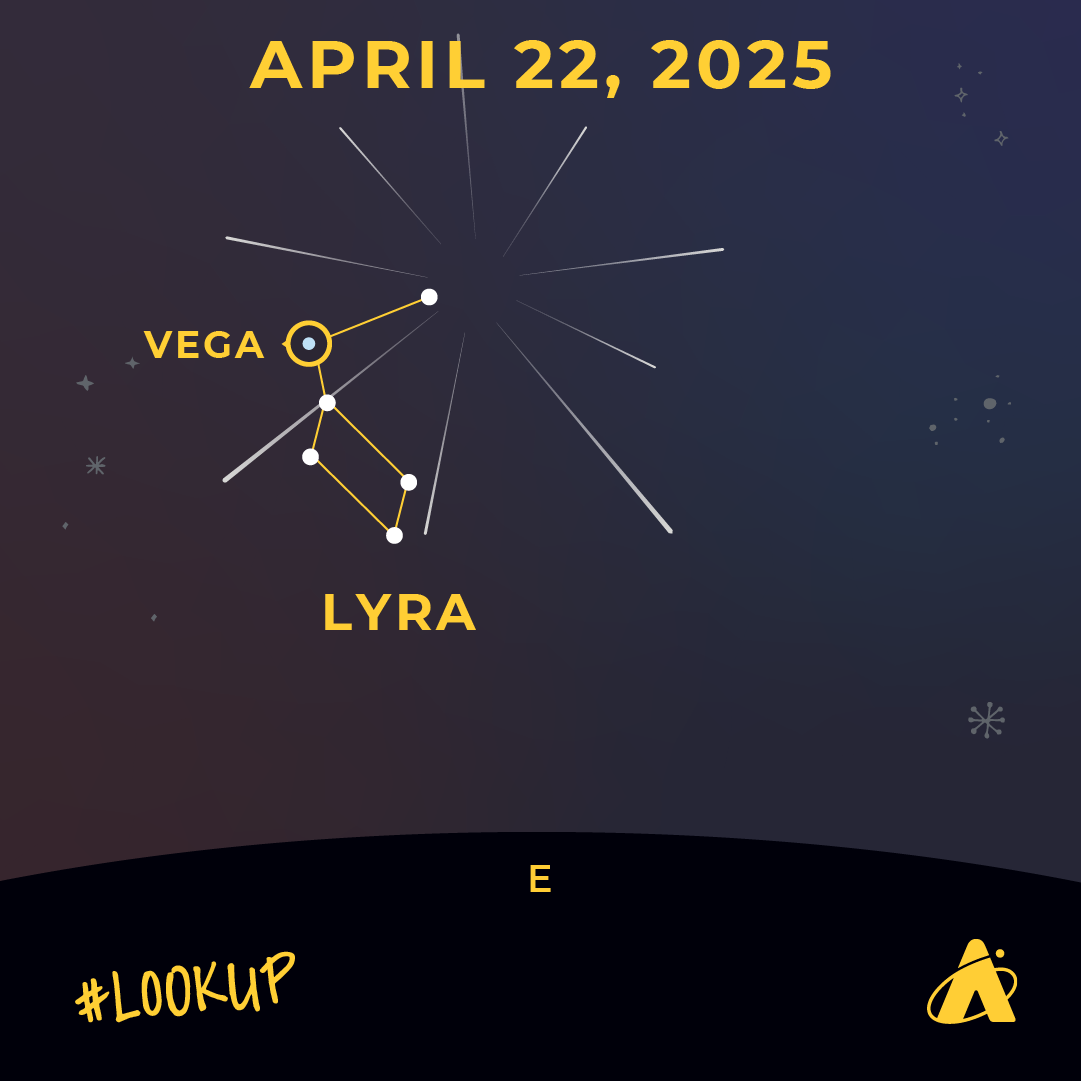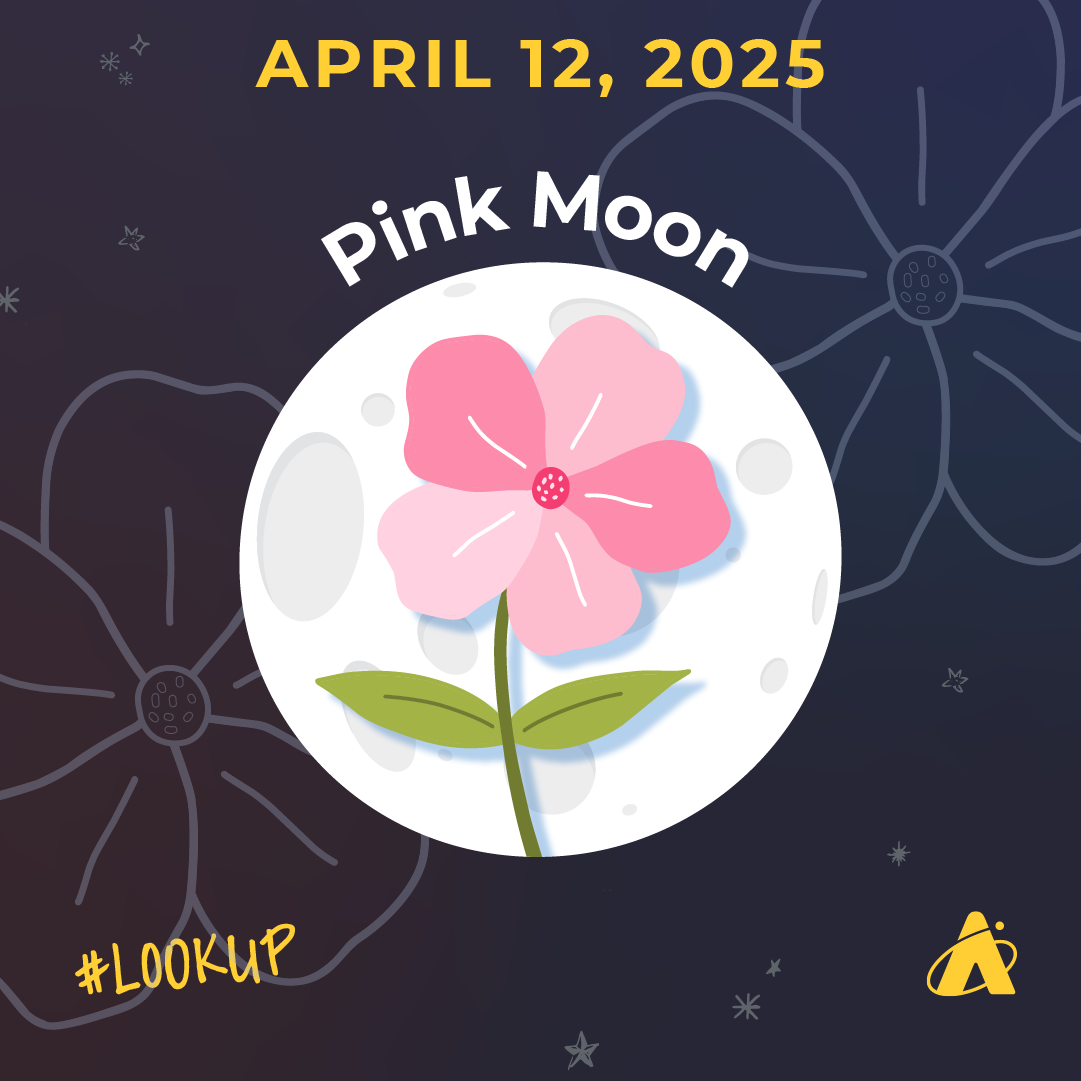Adler Skywatch: April 2025

Image caption: The stars Deneb, Vega, and Altair in the constellations Cygnus, Lyra, Aquila make up the “Summer Triangle,” which is visible in April, 2025. Image credit: Stellarium Web
The Sun becomes more prominent this month, but there’s still plenty to see in the night sky during April, 2025.
At the start of the month, the Sun is above the horizon for nearly 13 hours; and it’s more than 50 degrees high in the south at its highest. But it rises a little earlier and sets a little later each day. By month’s end, the Sun is up for slightly more than 14 hours, and it gets higher than 60 degrees up in the southern sky at midday.
Bright Stars In The Sky This April 2025
Though the Sun is in the sky longer each day this month, night-sky fans still have some good viewing opportunities. During April evenings, look toward the southwest for a last glimpse of wintertime’s bright stars Sirius, Rigel, Betelgeuse, Procyon, and Aldebaran. The star Sirius—in the Canis Major constellation—is the brightest and one of the lowest in the sky. About 25 degrees up from Sirius is Procyon, in the constellation Canis Minor.
From Sirius, look about 20 degrees to the right and slightly down to see Rigel, of the Orion constellation. About 20 degrees up from Rigel is the second-brightest star in Orion, Betelgeuse.
Then, if you draw an imaginary line from Sirius roughly through Orion’s three star belt, and continue further about the same distance, you’ll find Aldebaran, the brightest star in the constellation Taurus the Bull.
All these stars are low in the southwestern sky before 9:00 pm Central Daylight time early in the month. Later in the month, these bright stars start to set in the west-southwest during early-evening twilight, around 7:30 pm, so catch them while you can!
Visible Planets In April
Remnants of the “Planet Parade” that took place earlier this year also appear in the early-evening sky this month.
How To See Jupiter
The bright planet Jupiter is inside the constellation Taurus, about 50 degrees high in the west early in the month. It gets gradually lower in the sky each night—by the end of April, it’s only about 30 degrees high in the west-northwest. At about minus-2 magnitude this month, Jupiter far outshines the stars around it. The evenings of April 2, April 29 and April 30, it appears near a very slim waxing crescent Moon. Jupiter sets in the west-northwest, after midnight early in the month, and around 11:00 pm at the end of the month.
Where Is Mars?

This month, the planet Mars appears not far from the “twin stars” Pollux and Castor, in the Gemini constellation. During evening twilight, it’s about 70 degrees high in the southern sky at the start of the month, and sinks down to about 60 degrees high in the southwest sky by the end of the month.
At slightly brighter than first-magnitude, Mars is still brighter than either Pollux or Castor, but not by much. The night of April 5 into the early-morning darkness of April 6, Mars is near a waxing gibbous Moon. The red planet sets in the west-northwest around 3:00 am early in the month and shortly after 2:00 am by month’s end.
Can I See Mercury, Venus, Or Saturn?
The planets Mercury, Venus, and Saturn are clustered near the rising Sun this month making them nearly impossible to safely observe. Neptune is also in this cluster, but Neptune can never be seen without magnification, even under perfectly dark conditions.
Early in the month, the only planet in the group that may be visible is Venus. Due to its extreme brightness, Venus is often bright enough to be seen in morning twilight. Mercury and Saturn are comparatively faint and appear closer to the Sun than Venus this month, meaning they are likely to be invisible in dawn’s glare.
The Summer Triangle
In the early-morning darkness—after Jupiter, Mars, and the wintertime stars have set—the Summer Triangle starts to rise in the east-northeastern sky. The bright stars Vega in Lyra, Altair in Aquila, and Deneb in Cygnus, form a neat triangle about 20 degrees high and nearly 40 degrees long. At zero-magnitude, Vega is the brightest of the three stars. It’s also good to know the location of Vega, since it’s not far from the radiant point of the annual Lyrid meteor shower.
The 2025 Lyrid Meteor Shower

This year the Lyrids are forecast to peak in the late-afternoon of April 22, so try looking for meteors from the night of April 21 to before the Moon rises (around 3:00 am) in the early-morning darkness of April 22. Under very clear, very dark skies, about 10 to 15 meteors are expected. However, the Lyrids are known to have occasional meteor surges that could sporadically boost that count. Plus, about a quarter of Lyrids leave long trails of gas that glow for a few seconds after the meteor has passed, making this a good opportunity to see “shooting stars.”
Moon Phases In April 2025

First Quarter Moon: April 4
Full Moon: April 12, nicknamed the pink Moon
Last Quarter Moon: April 20
New Moon: April 27
Please note: these descriptions are for the Chicago area, using Central time.
Subscribe To Skywatch Wednesday This April
Tour the sky with the Adler Planetarium’s Theaters Manager, Nick, in Skywatch Wednesday. Nick uses cutting edge visualizations, NASA images, and astrophotography to show you what you can see in the night sky throughout the year.
Check out Nick’s latest episode for your guide to spring stargazing and details about last month’s total lunar eclipse!
Learn From Our Astronomy Educators
Watch recaps of Sky Observers Hangout livestreams this April! Learn how to observe upcoming cosmic happenings, enhance your astrophotography skills, and see celestial objects through a telescope virtually with our astronomy educators.
In the latest episode, Michelle and Hunter observe and discuss the March 2025 total lunar eclipse, answering all our viewers’s most pressing questions!






